蜡染英文ppt
- 格式:ppt
- 大小:3.67 MB
- 文档页数:14

蜡染PPT精选文档课件•蜡染概述•蜡染工艺流程•蜡染技艺展示与欣赏•蜡染在时尚产业中应用目•蜡染产业发展现状与趋势•总结回顾与展望未来录01蜡染概述蜡染定义与特点定义蜡染是一种古老的防染工艺,通过使用蜡刀蘸取熔蜡在布上描绘图案,再浸入染料中进行染色。
特点图案丰富多样,色彩鲜艳明快,具有独特的民族风格和艺术魅力。
蜡染历史渊源起源蜡染起源于秦汉时期,是中国古老的民间传统纺织印染手工艺之一。
发展在隋唐时期,蜡染技术得到了长足的发展,并传入了日本、东南亚等地区。
明清时期,蜡染工艺达到了巅峰,出现了许多精美的蜡染作品。
蜡染作为中国古老的民间手工艺,承载了丰富的民族文化和历史记忆。
民族文化传承艺术审美价值非物质文化遗产蜡染作品图案精美、色彩艳丽,具有极高的艺术审美价值。
蜡染技艺已被列入国家级非物质文化遗产名录,得到了广泛的保护和传承。
030201蜡染文化价值蜡染在服饰领域应用广泛,如蜡染布衣、蜡染围巾等,为服饰增添了独特的民族风情和艺术魅力。
服饰装饰蜡染作品也可用于家居装饰,如蜡染窗帘、蜡染桌布等,为家居环境增添了温馨的氛围和民族特色。
家居装饰蜡染技艺还可用于制作各种工艺品,如蜡染画、蜡染壁挂等,这些工艺品具有独特的艺术价值和收藏价值。
工艺品制作蜡染应用领域02蜡染工艺流程准备工作及材料选择确定蜡染作品用途和尺寸根据需要选择合适的布料、蜡和染料。
准备工具包括画笔、蜡刀、熔蜡器、染色盆等。
材料选择优质棉布或麻布作为画布,天然蜂蜡或合成蜡作为防染剂,环保型活性染料。
根据主题和审美需求,设计出具有民族特色的图案。
设计图案掌握线条粗细、疏密变化,运用点、线、面构成原理进行绘制。
绘制技巧保持图案清晰、对称,避免模糊和错位。
注意事项图案设计与绘制技巧控制蜡温保持适当的蜡温,避免过高导致布料烧焦或过低导致蜡无法均匀附着。
上蜡方法采用蜡刀蘸取适量熔化的蜡,在布上绘制出图案。
注意事项上蜡时要用力均匀,确保蜡层厚度一致;避免在同一处反复涂抹,以免蜡层过厚影响染色效果。
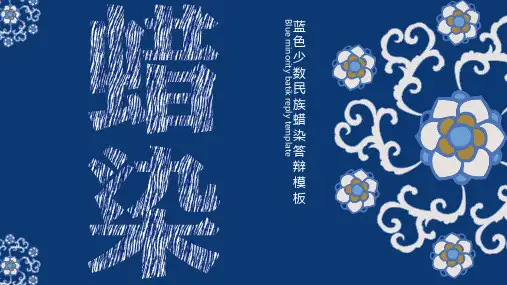


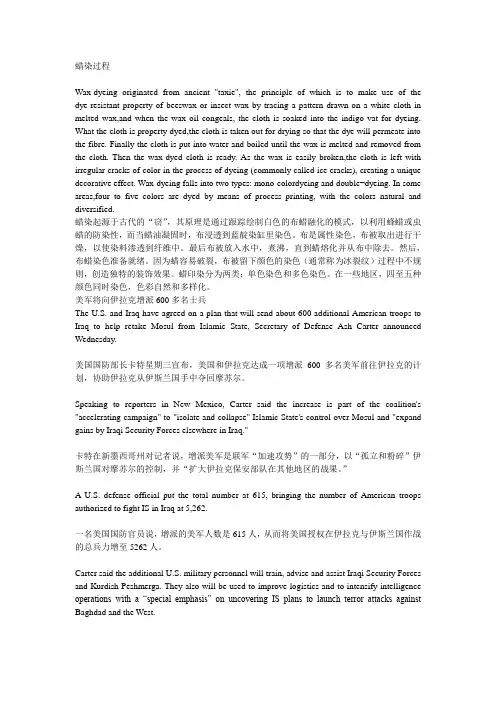
蜡染过程Wax-dyeing originated from ancient "taxie", the principle of which is to make use of the dye-resistant property of beeswax or insect wax by tracing a pattern drawn on a white cloth in melted wax,and when the wax oil congeals, the cloth is soaked into the indigo vat for dyeing. What the cloth is property dyed,the cloth is taken out for drying so that the dye will permeate into the fibre. Finally the cloth is put into water and boiled until the wax is melted and removed from the cloth. Then the wax-dyed cloth is ready. As the wax is easily broken,the cloth is left with irregular cracks of color in the process of dyeing (commonly called ice cracks), creating a unique decorative effect. Wax-dyeing falls into two types: mono-colordyeing and double¬dyeing. In some areas,four to five colors are dyed by means of process printing, with the colors natural and diversified.蜡染起源于古代的“窃”,其原理是通过跟踪绘制白色的布蜡融化的模式,以利用蜂蜡或虫蜡的防染性,而当蜡油凝固时,布浸透到蓝靛染缸里染色。
![2024版蜡染美术课件[1]](https://uimg.taocdn.com/8ab3c93b00f69e3143323968011ca300a6c3f6af.webp)
蜡染美术课件•蜡染艺术概述•蜡染工艺与技法•蜡染艺术的图案与色彩目录•蜡染作品欣赏与解析•蜡染艺术的传承与创新•蜡染艺术的实践与体验01蜡染艺术概述蜡染的起源与历史起源蜡染起源于古代,具体时间和地点已无从考证,但据推测可能起源于中国西南地区。
发展历程蜡染在古代被广泛应用于服饰、彩旗、彩帘等,后来逐渐发展成为一种独特的艺术形式。
随着时代的变迁,蜡染技艺不断传承和发展,形成了各具特色的地域风格。
以贵州、云南、四川等地的蜡染最为著名,风格粗犷、色彩鲜艳,多运用几何图案和动植物纹样。
西南地区中南地区东南沿海地区湖南、湖北等地的蜡染风格细腻、构图严谨,注重表现人物和故事情节。
如福建、广东等地的蜡染受海洋文化影响,风格独特,多运用海洋元素和民间传说。
030201蜡染的地域特色蜡染的艺术价值民族文化的传承蜡染作为一种独特的民族艺术形式,承载了丰富的历史文化内涵和民族精神,是民族文化传承的重要载体。
审美价值的体现蜡染作品以其独特的图案、色彩和构图,展现出极高的审美价值,给人以视觉上的享受和精神上的愉悦。
实用性与装饰性的结合蜡染不仅具有实用性,如用于服饰、家居用品等,还具有很高的装饰性,能够增添生活情趣和艺术氛围。
02蜡染工艺与技法蜡染的材料与工具材料蜂蜡、白布、染料(如靛蓝)、松香、酒精等。
工具熔蜡锅、画刀(用于刻画图案)、熨斗(用于加热熔蜡)、染缸(用于染色)、清水等。
选择优质的白布,准备好蜂蜡、染料等所需材料。
1. 准备材料在白布上用铅笔或炭笔设计出要制作的图案。
2. 设计图案将蜂蜡放入熔蜡锅中加热熔化。
3. 熔蜡用画刀蘸取熔化的蜂蜡,按照设计好的图案在白布上描绘。
4. 上蜡将上好蜡的白布放入染缸中,加入染料进行染色。
根据需要的颜色深浅,控制染色时间和温度。
5. 染色染色完成后,将白布从染缸中取出,用清水冲洗去除多余的染料,然后加热熨斗将布上的蜂蜡熔化去除。
6. 去蜡将去蜡后的布晾晒至干,完成蜡染作品。
7. 晾晒线条技法色彩搭配图案组合创新尝试蜡染的技法与技巧01020304运用不同粗细、长短的线条表现图案的轮廓和细节,增强画面的层次感和立体感。


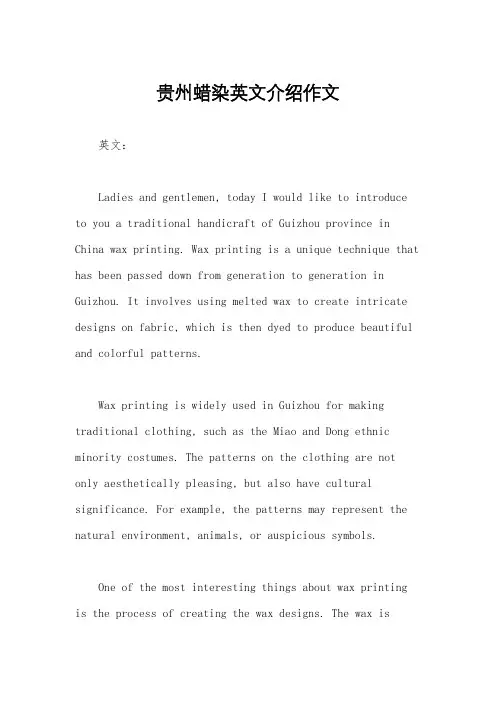
贵州蜡染英文介绍作文英文:Ladies and gentlemen, today I would like to introduce to you a traditional handicraft of Guizhou province in China wax printing. Wax printing is a unique technique that has been passed down from generation to generation in Guizhou. It involves using melted wax to create intricate designs on fabric, which is then dyed to produce beautiful and colorful patterns.Wax printing is widely used in Guizhou for making traditional clothing, such as the Miao and Dong ethnic minority costumes. The patterns on the clothing are not only aesthetically pleasing, but also have cultural significance. For example, the patterns may represent the natural environment, animals, or auspicious symbols.One of the most interesting things about wax printing is the process of creating the wax designs. The wax ismelted and applied to the fabric using a tool called a canting. The canting is a small metal container with a spout, which allows the wax to flow out in a controlled manner. The wax is then left to cool and harden, afterwhich the fabric is dyed. Once the dye has set, the wax is removed by boiling the fabric in hot water, revealing the intricate wax designs underneath.中文:各位女士先生们,今天我想向大家介绍中国贵州省的一种传统手工艺品——蜡染。
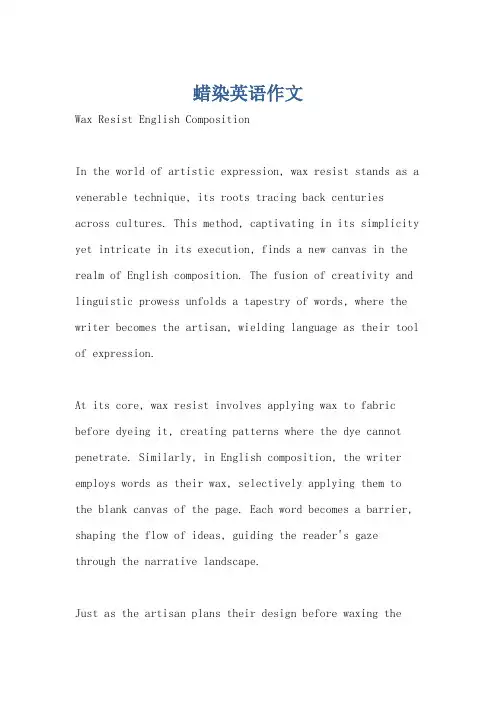
蜡染英语作文Wax Resist English CompositionIn the world of artistic expression, wax resist stands as a venerable technique, its roots tracing back centuries across cultures. This method, captivating in its simplicity yet intricate in its execution, finds a new canvas in the realm of English composition. The fusion of creativity and linguistic prowess unfolds a tapestry of words, where the writer becomes the artisan, wielding language as their tool of expression.At its core, wax resist involves applying wax to fabric before dyeing it, creating patterns where the dye cannot penetrate. Similarly, in English composition, the writer employs words as their wax, selectively applying them to the blank canvas of the page. Each word becomes a barrier, shaping the flow of ideas, guiding the reader's gaze through the narrative landscape.Just as the artisan plans their design before waxing thefabric, the writer must craft a blueprint for their composition. Ideas swirl like colors in a palette, waiting to be arranged into a coherent pattern. With careful consideration, the writer selects their motifs, their themes, each stroke of the pen contributing to theintricate design of the final piece.Yet, as with any artistic endeavor, the process is not without its challenges. The wax may crack, allowing the dye to seep where it is unwanted, disrupting the intended harmony of the design. Similarly, in writing, the flow of ideas may falter, the carefully constructed structure threatened by the intrusion of errant thoughts. Here, the writer must exercise diligence, refining their composition with each edit, ensuring that every word serves its purpose in maintaining the integrity of the piece.The beauty of wax resist lies in its unpredictability. No two creations are ever identical; each bears the imprint of the artisan's hand, a testament to their skill and vision. Similarly, in English composition, the writer's voice emerges through their words, infusing the piece with theirunique perspective and personality. It is thisindividuality that lends depth and richness to the work, inviting the reader to immerse themselves fully in the narrative world.As the dye sets and the wax is removed, the true beauty of the design is revealed in all its glory. So too does the English composition, its essence laid bare for the reader to behold. Through the careful application of words, the writer has created a masterpiece, a testament to the power of language to evoke emotion, provoke thought, and transcend the boundaries of time and culture.In the end, whether through fabric or prose, wax resist is more than just a technique; it is a form of expression, a means of capturing the imagination and bringing dreams to life. In the hands of the skilled artisan, or the adept writer, it becomes a tool of transformation, turning the ordinary into the extraordinary, and leaving an indelible mark on the canvas of human experience.。
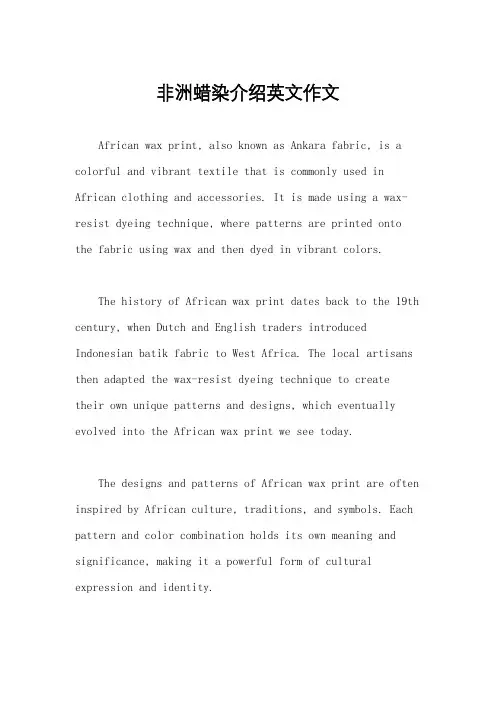
非洲蜡染介绍英文作文African wax print, also known as Ankara fabric, is a colorful and vibrant textile that is commonly used in African clothing and accessories. It is made using a wax-resist dyeing technique, where patterns are printed onto the fabric using wax and then dyed in vibrant colors.The history of African wax print dates back to the 19th century, when Dutch and English traders introduced Indonesian batik fabric to West Africa. The local artisans then adapted the wax-resist dyeing technique to createtheir own unique patterns and designs, which eventually evolved into the African wax print we see today.The designs and patterns of African wax print are often inspired by African culture, traditions, and symbols. Each pattern and color combination holds its own meaning and significance, making it a powerful form of cultural expression and identity.African wax print is not only used in clothing, but also in home decor, accessories, and even art. It has become a symbol of African identity and pride, and is often worn during special occasions and celebrations to showcase one's cultural heritage.The process of making African wax print is a labor-intensive and intricate craft, involving skilled artisans and meticulous attention to detail. Each piece of fabric is carefully hand-printed and dyed, resulting in a unique and one-of-a-kind product.In recent years, African wax print has gainedpopularity in the fashion industry worldwide, with designers and fashionistas incorporating it into their collections. Its bold and vibrant aesthetic has made it a favorite among those who appreciate unique and culturally rich textiles.。